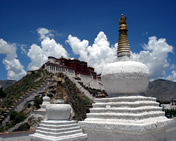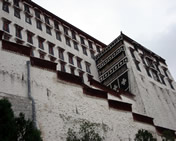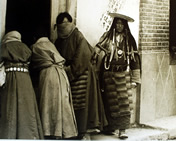Tibet History
History of Tibet

Tibet has a recorded history of about 1,300 years and it can be divided into four periods:
1. The Period of Tsanpo
This period starts from Nyatri Tsanpo in 127 B.C and ends in 842 A.D. And the kingdom had the largest territory during this period. During this period some 42 Tsanpos had ruled over Tibet among which Songtsen Gampo's rule was considered as the zenith. Songtsen Gampo was an outstanding ruler, he unified Tibet, changed his capital to Lhasa, sent Sambhota to India to study Sanskrit and promulgated a script for the Tibetan on the latter's arrival to Tibet, married Princess Wencheng of the tang Court and Princess Bhrikuti Debi of Nepal, built the Potala Palace and the Temple of Jokhang.

2. The Period of Decentralization
After the fall the Tupo Regime, Tibet had seen 400 years of division, local powers and wars. This period began in 842 A.D, the year of Lang Dharma's assassination, and ended in about 1260 A.D, when Pagpa, the Abbot of Sakya monastery, became a vassal of Kublai Khan, the first Emperor of the Yuan Dynasty. During this period a little is known in history except that Tibet became decentralized into a number of petty principalities.
3. The Period of Sakya, Pagdu and Karmapa's Rule
This period lasted from 1260 A.D to 1642 A.D during which political powers centered in the three regions of Sakya, Pagdu and Tsang successively ruled over Tibet. This period began with Sakya's rule over Tibet, followed first by Pagdu's rule in Lhaoka and then by Karmapa's rule in the Tsang region (Shigatse). The Sakya period was the time when Tibet officially became an inseparable part of China.

4. The Period of Gandan Podrang's Administration
This period started in 1642 A.D. when the 5th Dalai Lama overtook the ruling power from the Tsang ruler. That means in the Ming and Qing Dynasty, the central government of China strengthened its administrative grip on Tibet. In 1949, People's Republic of China was founded. The government stuck to the policy of peaceful liberation of Tibet. As a result, Tibet was liberated peacefully in 1951. The policy of regional national autonomy was exercised in Tibet. The democratic reform wad carried out and the feudal serfdom was abolished. In September 1965, Tibet Autonomous Region was established. In recent years, the Tibetan people together with the Chinese people of all nationalities fought against the imperialist invasion and upheld the unified motherland of China.
Attractions you may also like:
Tibet Group Tour
-
12 Days Lhasa-EBC-Namtso-Nyingchi Group Tour from $1150
-
9 Days Classic Trip to EBC with Namtso Lake from $895
-
5 Days Lhasa-Namtso-Lhasa Group Tour from $568
-
7 Days Central Tibet Group Tour with Namtso from $712
-
4-Day Lhasa Join-in Group Tour from $356
-
5 Days Lhasa Group Tour with Yamdrok Lake from $530
-
5 Days Lhasa Pilgrimage Tour to Ganden Monastery & Drak Yerp from $530
-
6 Days Lhasa Shigatse Clssic Group Tour from $620
-
7 Days Overland Tour from Lhasa to Kathmandu from $780
- Lhasa Travel Guide
- Shigatse Travel Guide
- Nyingchi Travel Guide
- Ngari Travel Guide
- Lhokha Travel Guide
- Nagchu Travel Guide
- Chamdo Travel Guide
- Tibetan Culture
- Tibet Weather
- Tibet Map
- Tibet Tourism News